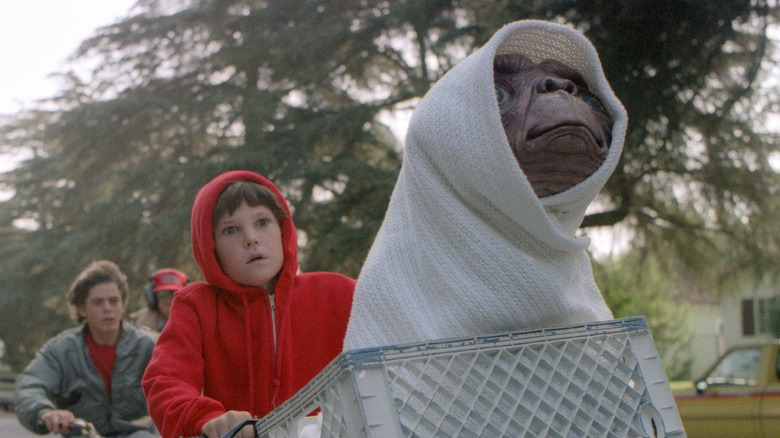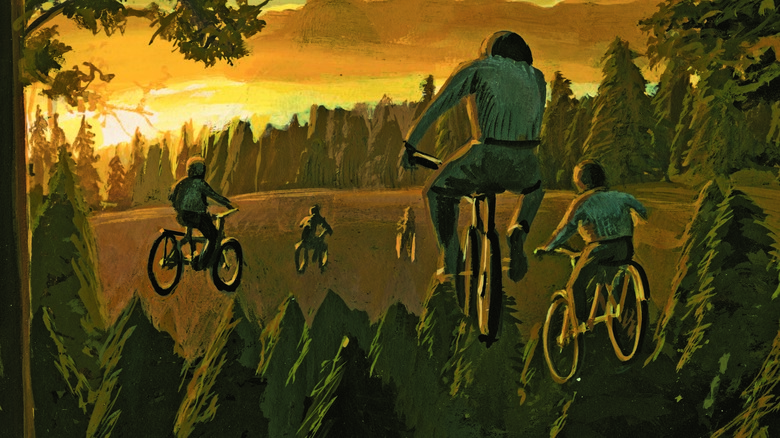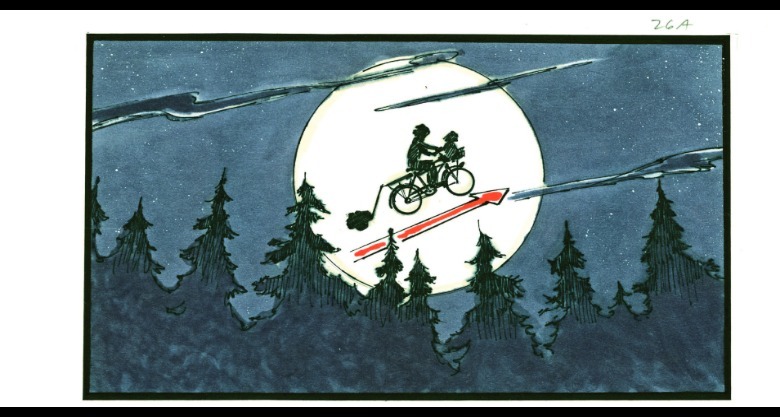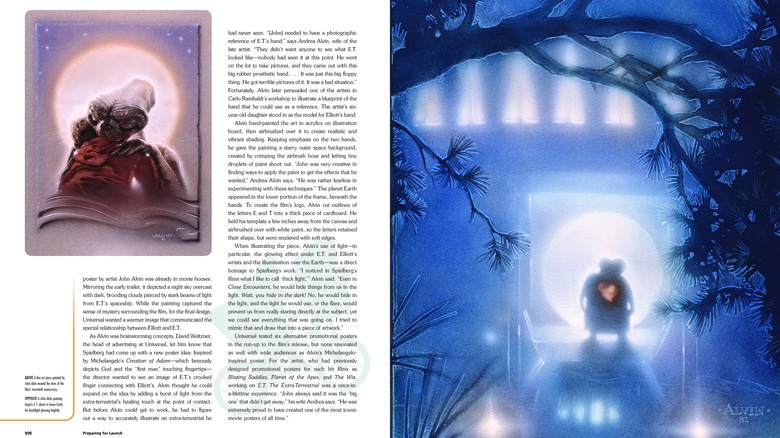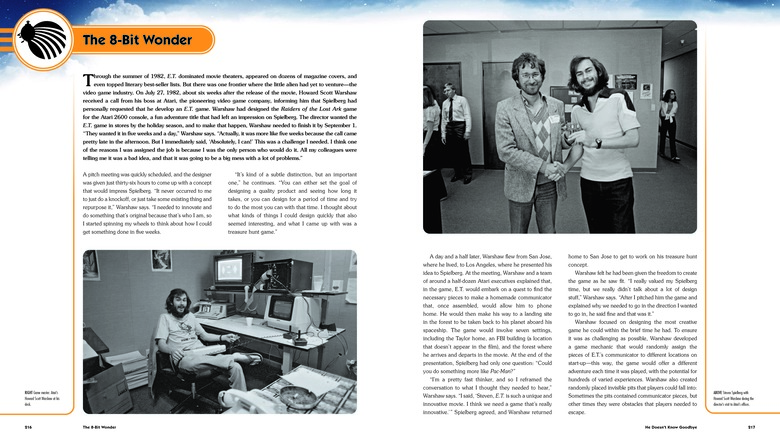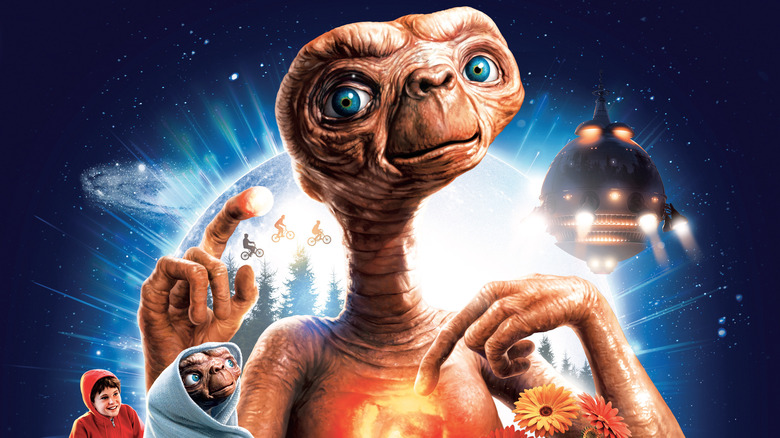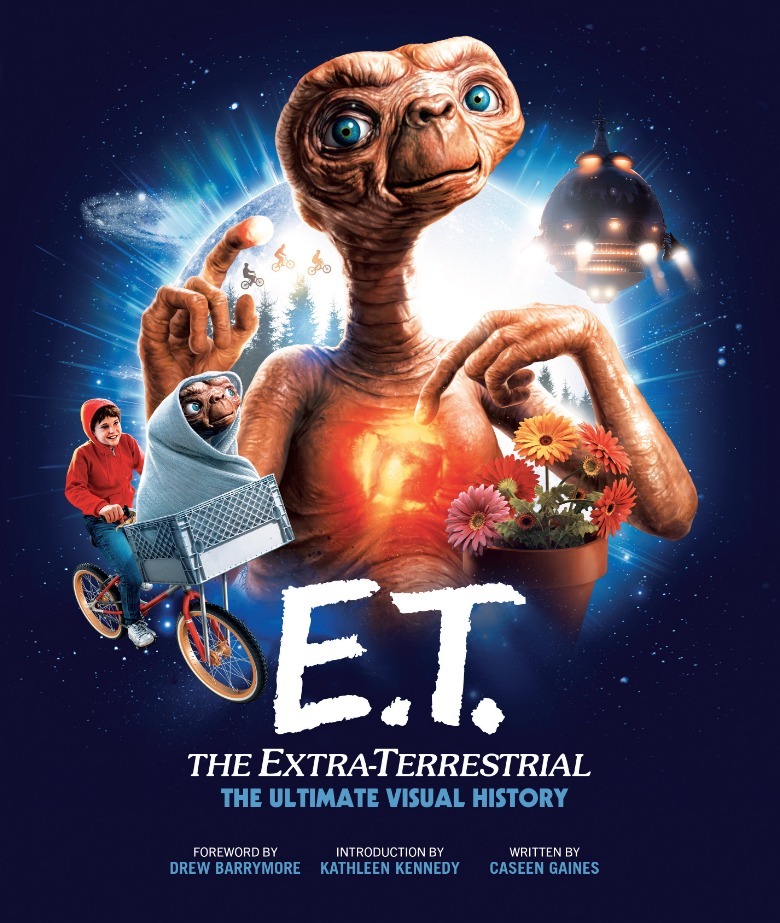E.T. The Extra-Terrestrial: The Ultimate Visual History Takes Us Through The History Of Spielberg's Masterpiece [Exclusive]
Steven Spielberg's "E.T. the Extra-Terrestrial" is the stuff of movie magic. Channeling his own childhood, Spielberg created one of his greatest films — the story of a lonely kid who befriends an alien. With his emotional, stirring, funny adventure, Spielberg conjured up nostalgia and created something often imitated but never duplicated. First planned as a scary film about aliens invading a farm, "E.T" eventually morphed into something sweeter. "For the better part of five decades, Hollywood treated aliens as hostile invaders," Spielberg said, "but I felt that had been done enough. I always regarded the heavens as a source of great solace, curiosity, and wonder ..."
Believe it or not, "E.T." turns 40 this year (newsflash: you're old!), and in honor of that anniversary, the new book "E.T. the Extra-Terrestrial: The Ultimate Visual History," by Caseen Gaines and published by Insight Editions, gives us a look at "E.T." from its inception all the way through its place as a pop-culture phenomenon. We have an exclusive look at the book, including concept art and a look at the now-infamous "E.T." Atari game, below.
Taking flight
In the above concept art, we have a glimpse of the wonderful moment in the film where E.T. makes bikes take flight. The warm colors of sunset come through this art and conjure up a feeling of magic that Spielberg would effectively capture in the final film. No matter how old and jaded I get, anytime I watch the moment the bikes lift off and hear John Williams' iconic score kick in, I am rendered a blubbering mess. I am transported back to a childhood I don't even have much fondness for, and am reminded of a time when movies on the big screen really felt like magic. Where practical effects rather than digital were used to bring dreams to life.
Another bit of art below gives us a look at the earlier moment when E.T. and his human friend Elliott take to the sky, flying in front of the moon. This is probably the most famous image from "E.T.," and one of the most famous images in the history of film. It would, of course, become the logo for Spielberg's production company, Amblin.
'It was this big floppy thing'
Above you'll see two pieces from John Alvin. Alvin would eventually create the film's poster, featuring E.T.'s long finger reaching out to Elliot's. The idea came from Spielberg, inspired by Michelangelo's painting "Creation of Adam." As Gaines writes:
"Alvin thought he could expand on the idea by adding a burst of light from the extra-terriestrial's healing touch at the point of contact."
But that wouldn't be entirely easy — Alvin needed reference photos of E.T. to work with, but that wasn't a simple request. Andrea Alvin's wife states:
"They didn't want anyon to see what E.T. looked like — nobody had seen it at this point. [John Alvin] went on the lot to ake pitures, and they came out with this big rubber prosthetic hand ... It was this big floppy thing. He got terrible pictures of it. It was a bad situation."
The 8-bit wonder
The "E.T." videogame from Atari, released in 1982, is probably just as famous as the film — but for all the wrong reasons. "E.T." was a huge hit and fast on its way to becoming a pop culture phenom, and Atari thought the game, released around Christmas, was going to be a big deal. Unfortunately, terrible graphics and bad gameplay rendered the game a flop. It was so much of a failure, in fact, that Atari ended up burying extra copies of the game in landfill (it's worth noting that Atari did this to other games too, not just "E.T." Ultimately, 728,000 were buried).
Rather than ignore this unfortunate moment in "E.T." history, "E.T. the Extra-Terrestrial: The Ultimate Visual History" delves into the story. You can read an exclusive excerpt from the Atari game chapter below.
Through the summer of 1982, E.T. dominated movie theaters, appeared on dozens of magazine covers, and even topped literary best-seller lists. But there was one frontier where the little alien had yet to venture—the video game industry. On July 27, 1982, about six weeks after the release of the movie, Howard Scott Warshaw received a call from his boss at Atari, the pioneering video game company, informing him that Spielberg had personally requested that he develop an E.T. game. Warshaw had designed the Raiders of the Lost Ark game for the Atari 2600 console, a fun adventure title that had left an impression on Spielberg. The director wanted the E.T. game in stores by the holiday season, and to make that happen, Warshaw needed to finish it by September 1. "They wanted it in five weeks and a day," Warshaw says. "Actually, it was more like five weeks because the call came pretty late in the afternoon. But I immediately said, 'Absolutely, I can!' This was a challenge I needed. I think one of the reasons I was assigned the job is because I was the only person who would do it. All my colleagues were telling me it was a bad idea, and that it was going to be a big mess with a lot of problems."
A pitch meeting was quickly scheduled, and the designer was given just thirty-six hours to come up with a concept that would impress Spielberg. "It never occurred to me to just do a knockoff, or just take some existing thing and repurpose it," Warshaw says. "I needed to innovate and do something that's original because that's who I am, so I started spinning my wheels to think about how I could get something done in five weeks.
"It's kind of a subtle distinction, but an important one," he continues. "You can either set the goal of designing a quality product and seeing how long it takes, or you can design for a period of time and try to do the most you can with that time. I thought about what kinds of things I could design quickly that also seemed interesting, and what I came up with was a treasure hunt game."
E.T. the Extra-Terrestrial: The Ultimate Visual History
The definitive account of the motion picture phenomenon, E.T. the Extra-Terrestrial: The Ultimate Visual History is a must-have for fans of the beloved Steven Spielberg classic.
Documenting the complete history of E.T., the book explores Spielberg's initial inspiration for the story, the challenging shoot, and the record-breaking success, as well as the film's endurance, examining the merchandising it inspired and the reasons E.T. holds a permanent place in the hearts of movie fans the world over.
E.T. the Extra-Terrestrial: The Ultimate Visual History features exclusive interviews with key members of the creative team, including cast and crew. Filled with visual treasures, the book also includes rare and never-before-seen imagery from the Amblin Entertainment archives, including on-set photography, concept art, and storyboards, plus a wealth of removable insert items, such as annotated script pages, studio memos, preliminary sketches, and more.
" E.T. the Extra-Terrestrial: The Ultimate Visual History" by Caseen Gaines, with a foreword by Drew Barrymore and an introduction by Kathleen Kennedy, is on sale now.
